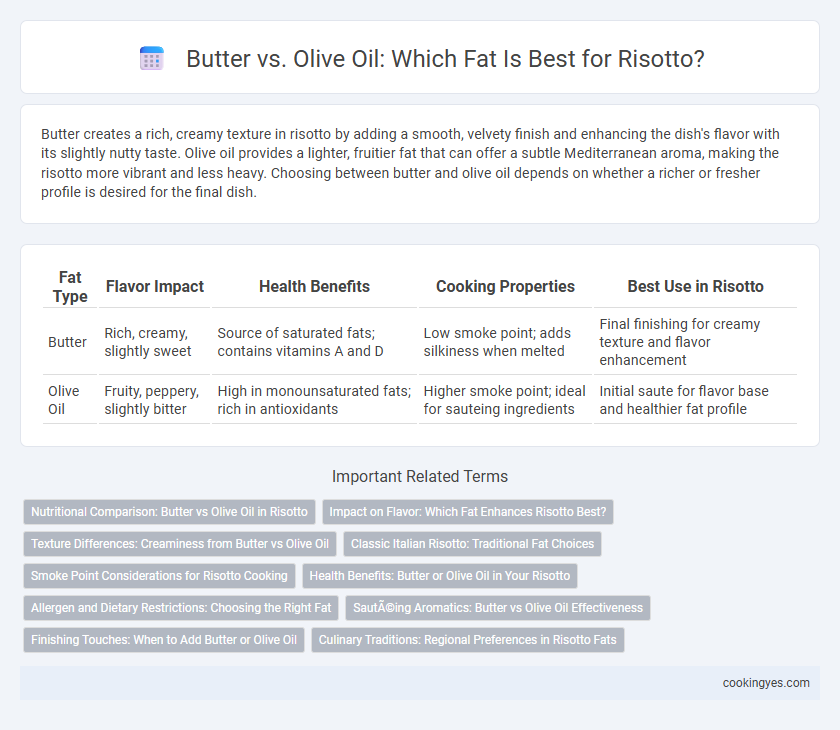Butter creates a rich, creamy texture in risotto by adding a smooth, velvety finish and enhancing the dish's flavor with its slightly nutty taste. Olive oil provides a lighter, fruitier fat that can offer a subtle Mediterranean aroma, making the risotto more vibrant and less heavy. Choosing between butter and olive oil depends on whether a richer or fresher profile is desired for the final dish.
Table of Comparison
| Fat Type | Flavor Impact | Health Benefits | Cooking Properties | Best Use in Risotto |
|---|---|---|---|---|
| Butter | Rich, creamy, slightly sweet | Source of saturated fats; contains vitamins A and D | Low smoke point; adds silkiness when melted | Final finishing for creamy texture and flavor enhancement |
| Olive Oil | Fruity, peppery, slightly bitter | High in monounsaturated fats; rich in antioxidants | Higher smoke point; ideal for sauteing ingredients | Initial saute for flavor base and healthier fat profile |
Nutritional Comparison: Butter vs Olive Oil in Risotto
Butter in risotto provides a rich source of saturated fats and fat-soluble vitamins like A and E, contributing to creamy texture and taste. Olive oil contains primarily monounsaturated fats, known to support heart health and reduce inflammation, while adding a fruitier, lighter flavor to risotto. Nutritionally, olive oil offers healthier fats and antioxidants, whereas butter contributes more saturated fat and cholesterol, impacting overall lipid profile differently.
Impact on Flavor: Which Fat Enhances Risotto Best?
Butter enriches risotto with a creamy, rich flavor and adds a silky texture that enhances the dish's indulgence. Olive oil imparts a fruity, slightly peppery taste, offering a lighter, more Mediterranean profile that balances the rice's starchiness. Choosing butter or olive oil depends on whether you prefer a decadent, buttery depth or a fresh, aromatic finish to elevate the risotto experience.
Texture Differences: Creaminess from Butter vs Olive Oil
Butter imparts a rich, creamy texture to risotto due to its milk fat content, which enhances smoothness and adds a velvety mouthfeel. Olive oil provides a lighter, silkier consistency with a subtle fruity flavor, creating a less dense but still luxurious texture. Choosing butter emphasizes richness and creaminess, while olive oil offers a delicate balance that highlights the rice's individual grains.
Classic Italian Risotto: Traditional Fat Choices
Classic Italian risotto traditionally employs butter for its rich, creamy texture and ability to enhance the dish's velvetiness during the finishing stage. Olive oil, favored in northern Italy, offers a lighter taste and is often used for sauteing the soffritto without overpowering the delicate flavors of risotto rice varieties like Arborio or Carnaroli. Choosing butter or olive oil affects the mouthfeel and authenticity of risotto, with butter providing depth and olive oil lending a subtle fruitiness aligned with regional Italian culinary practices.
Smoke Point Considerations for Risotto Cooking
Butter, with a lower smoke point of around 350degF (175degC), provides rich flavor but requires careful temperature control in risotto to avoid burning. Olive oil, especially extra virgin, has a higher smoke point near 375-410degF (190-210degC), offering better heat tolerance and smoother cooking without compromising taste. Selecting the appropriate fat based on smoke point enhances the texture and prevents bitterness, crucial for perfect risotto preparation.
Health Benefits: Butter or Olive Oil in Your Risotto
Olive oil offers heart-healthy monounsaturated fats and antioxidants that reduce inflammation, making it a nutritious choice for risotto. Butter provides a rich flavor and contains fat-soluble vitamins like A and E but also has higher saturated fat content, which may impact cholesterol levels. Choosing olive oil enhances the health profile of risotto without compromising creaminess, supporting cardiovascular health more effectively than butter.
Allergen and Dietary Restrictions: Choosing the Right Fat
Butter, containing dairy proteins, poses allergen risks for individuals with lactose intolerance or milk allergies, making olive oil a safer choice for those with dietary restrictions. Olive oil, being plant-based and free from common allergens, suits vegan and dairy-free diets, enhancing inclusivity in risotto preparation. Selecting olive oil or allergen-free butter alternatives ensures compliance with specific nutritional needs without compromising the creamy texture essential to authentic risotto.
Sautéing Aromatics: Butter vs Olive Oil Effectiveness
Butter provides a rich, creamy flavor and helps achieve a silky texture when sauteing aromatics for risotto, while olive oil offers a higher smoke point and a slightly fruity undertone. Choosing butter enhances the dish's depth due to its milk solids that caramelize gently, contributing to a more complex aroma. Olive oil's stability at higher temperatures prevents burning and preserves the fresh, vibrant notes of ingredients like garlic and onions.
Finishing Touches: When to Add Butter or Olive Oil
For finishing touches in risotto, adding butter just before serving enhances creaminess and richness, creating a smooth texture that balances the starchiness of the rice. Olive oil is often used during cooking for its robust flavor and health benefits, but it lacks the velvety finish that butter provides when stirred in at the end. Incorporating butter at the final stage seals in flavor and delivers the traditional luxurious mouthfeel essential for authentic risotto.
Culinary Traditions: Regional Preferences in Risotto Fats
Northern Italian risotto recipes traditionally favor butter for its rich, creamy texture and ability to enhance the dish's delicate flavors, especially in regions like Lombardy and Piedmont. Southern Italian variations often incorporate olive oil, aligning with the Mediterranean diet and providing a lighter, fruitier taste. These regional preferences in fat choice reflect centuries-old culinary practices and influence the final risotto's flavor profile and mouthfeel.
Butter vs olive oil for risotto fat Infographic

 cookingyes.com
cookingyes.com